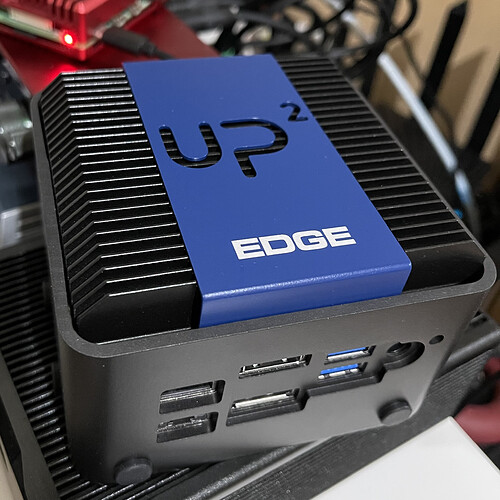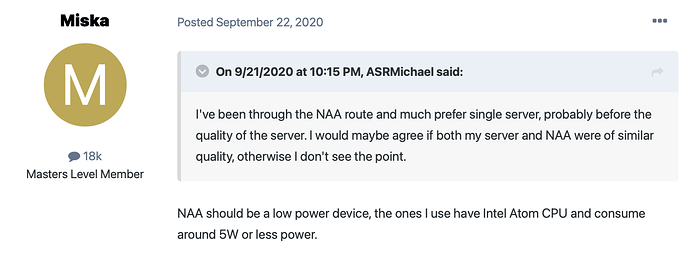I currently own a Spring 2 KTE with a Pi2AES (max 192 PCM) endpoint, and I’m likely to get a Spring 3 or May KTE for a different system later in the year. I’d like to bring HQ Player into the mix. To go above 192 PCM, I’d have to use USB or I2S. The baseline would be Pi 4 USB. Anything clearly better?
To support PCM1536 kHz upsampling (which Spring3 and May support) you need Intel based NAA.
On his website Jussi has recommended hardware like the below.
I have one and it is fantastic. Allows for some cool HQPlayer features like USB UAC2 input into HQPlayer.
https://up-shop.org/up-gateway-atom-x5-z8350-w-4g-memory-32g-emmc-board-w-vesa-plate.html
I’ve been very happy with an old microRendu and Ultracap Power Supply. These are the current versions:
https://sonore.us/microRendu.html
What they describe as ‘output modes’ are actually software switchable inputs.
The mR 1.5 maxes out at 768 KHz PCM and DSD 512, which is below the max inputs the Spring 3 or May can handle. I used to feed my mR DSD 512 and it was fine, but now I have rolled back to DSD 256 to use the 7EC modulators and ext2 filter with HQ Player.
I was surprised at the improvement that the UltraCap power supply made when I fed the mR with it.
Before I sold my Denafrips Ares, I got the MicroRendu up to 1536khz using HQPLAYER. It was stunningly good. I am currently deciding between the Denafrips Pontus and the Spring 3 as my next upgrade.
V
UP Squared is an excellent NAA endpoint. The top-of-the-line Pentium N4200 version is capable for PCM upsampling to 1.4112 / 1.536MHz. I use it on my Denafrips Ares II. The new fanless aluminum case is durable and looks good!
Nice ! The model I linked is a bit cheaper and also supports PCM1.5MHz too according to Jussi (from memory).
Nice to have a few different options.
Are you going to order one with the Titanis / Optional USB module? If so, I highly recommend the Mele Intel Mini PC Stick: https://www.amazon.com/gp/product/B08V8VJF6L/ref=ppx_yo_dt_b_asin_title_o02_s01?ie=UTF8&th=1
I own this and it works fantastic. I can upsample to 1.536MHz PCM without any issues.
If you aren’t going to be having the Titanis, then, don’t get the above NAA (it shall work fine but won’t sound as good). Get either a SoTM SMS-200Ultra Neo or Sonore ultraRendu. I own both as well. I can upsample to either 768KHz PCM using LNS15 / Sinc-L or DSD256 using ASDM7EC / poly-sinc-ext2 with them.
They both sound quite different from each other: the SMS-200Ultra Neo is euphonic / musical whereas the ultraRendu has a super-low noise floor and is more ‘audiophile’.
PM me if you want to buy either of them from me or if you want to know more about the differences between them.
Hope this helps.
Thanks, but I’m a bit confused, the one that looks like yours does not use N4200: UP Squared Edge systems - [4GB RAM] UP Squared AI Edge system
I purchased the board and case kit (heat sink compound included) separately then assembled it by myself. BTW please remember to order a 5V / 6A SMPS from UP shop. This UP^2 board needs 4~6 ampere (4A is the minimum requirement. If you want this UP^2 to do the USB Audio Class 2 input, you definitely need 6A).
My UpBoard Gateway that I linked above is easily powered by a 1A powerbank.
I’m using UAC2 input.
Maybe another good reason to stick with the Gateway model which Jussi also uses and recommends.
The UP^2 I got (Pentium N4200 / 8GB RAM / 64GB eMMC) is 100% same board as Gateway’s which Mr Laako’s recommended.
No, check what I linked above.
Gateway features Intel Atom SoC…
If you click the “recommended hardware” hyper link from signalyst.com it leads to Pentium N4200, not Atom.
Even using Atom it still requires 4 ampere (consumes 13 watts in general).
I’m not speaking theoretically. I have one and using one right now with 1A powerbank.
5V x 1A = 5W.
See this post by @jussi_laako linking to the same UpBoard Gateway I use (Intel Atom SoC):
And @Chunhao_Lee if my practical experience doesn’t convince you, Jussi also mentions <5W consumption. Nothing like the 13W figure you mention.
You are reading the spec sheet. Myself and Jussi are talking about practical experience here.
If it needed 13W as you say, I wouldn’t have been able to use this for the past ~3 years 
So anyway my recommendation is still the Intel Atom model I have linked above (which Jussi has also).
If you use 1A and feel good, go with it. I’m totally fine with it.
I’m not a reading-spec-guy. All I see is the device connecting requirement. One USB 2.0 for your DAC and one USB for your booting flash drive, needs 500mA each. Gigabit Ethernet NIC might need 2~13 watts based on research. If you want your NAA has high quality sound, sufficient ampere is fundamental.
Once we get into sound quality discussion, that’s where I exit.
The 1A consumption changes if your USB DAC is fully powered over USB input. That’s the only case it gets anywhere near 0.5A consumption… Not the case with the Holo DACs of this thread.
My recommendation is to copy Jussi’s NAAs.
Pretty safe advice for other people (not you) if you ask me ![]()
Lowest power consumption NAA is what you want. See screenshot of Jussi above.
The USB module that Holo DACs use is powered by USB on XMOS side. Newer version of the module includes Titanis circuit that consumes more power from USB (the external Titanis dongle has two versions: 300mA and 800mA, for reference). So this is the case.
I totally agree. Mr Laako choose Mean Well’s GSM60B05-P1J medical power supply which is 5V / 6A for his NAA. Why don’t you? ![]()
I wasn’t aware the Holo DACs chew so much power. Thanks for the correction.
None of my current DACs use more than 0.1A on USB input. Probably why 1A is sufficient for me.
I’m curious if @jussi_laako’s comment about <5W consumption with UpBoard (Intel Atom) also applies to his Holo or if that is an exception.
<5W certainly applies to his RME ADI-2 (which I use also).

